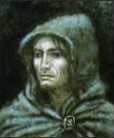5.04. The Siege of Gondor by Ingold
‘The Siege of Gondor’ and subsequent ‘Battle of Pelennor Fields’ contain some of the most important events in both the book and movie. Courage, madness, devotion to duty, dignity, and honour are all to be found in this apocalyptic struggle for the fate of Middle-earth. Will Sauron, his Wraiths, Orcs, and his human allies control the fate of the world or will Gondor, Rohan, and the free peoples of Middle-earth band together to thwart their designs? In the book as well as the movie this is shown to be a brutal slugging match between two great powers but there are differences to be found still: both in the order of battle and characters involved in the battle as we shall see.
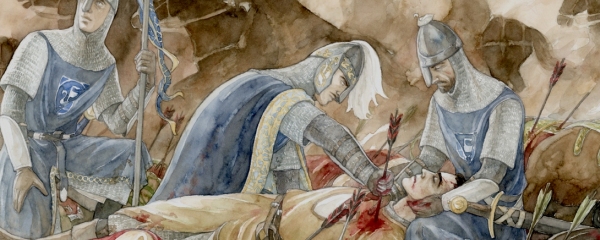
Faramir Returns Home
One of the first main differences in “Siege of Gondor” book to film is when Faramir returns from his unsuccessful mission to retake (hold in the book) the city of Osgiliath. The first lies in what precisely happened to Faramir. In the book Denethor releases a sortie of Knights of Dol Amroth lead by the Prince Imrahil as described in ROTK: And then a trumpet rang from the Citadel and Denethor at last released the sortie. Drawn up within the shadow of the Gate and under the looming walls outside they had waited for his signal: all the mounted men that were left in the City. Now they sprang forward, formed, quickened to a gallop and charged with a great shout. And from the walls an answering shout went up; for foremost on the field rode the swan-knights of Dol Amroth with their Prince and his blue banner at their head. [5.IV.]
Imrahil leads his knights in a heroic charge and breaks the lines of Mordor long enough to rescue Faramir and his men. Imrahil then brings back a critically injured Faramir to the great grief of the people of Gondor.
In the movie, Faramir’s return is more understated: the armies of Mordor are advancing rapidly on Minas Tirith and the unfortunate captain of Gondor is dragged through the Great Gate by his horse then brought to the pinnacle of Mindolluin by a group of Gondorian guards.
Denethor’s Reaction
Denethor’s reaction to his son’s return is also somewhat different. In the book it goes like this: …Denethor rose and looked on the face of his son and was silent. Then he bade them make a bed in his chamber and lay Faramir upon it and depart…And when Denethor descended again he went to Faramir and sat beside him without speaking, but the face of the Lord was grey, more deathlike than his son’s. [5.IV.]
We see that Denethor is melancholic in his grief whereas in the movie Denethor is instantly horrified and grief-stricken; he immediately believes his son is mortally wounded. He then lurches back and starts proclaiming that his sons are spent, his line has ended, and the House of Stewards has failed. He sees the armies of Morgul and commands his men to retreat after which he is promptly relieved of command in a rather unique manner by Gandalf.
Denethor in the book on the other hand, has no time for anything other than his dying son, not even the defence of the city which he cedes voluntarily to Gandalf.
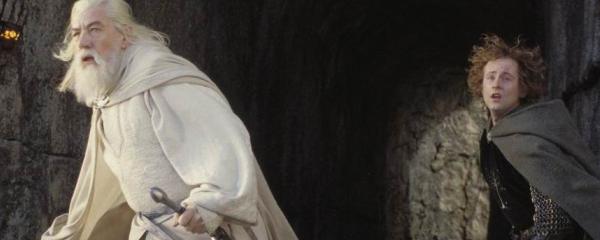
The Battle for Minas Tirith
In the book there is hardly any battle for Minas Tirith before the arrival of the army of Rohan. Mordor dedicates itself to psychologically breaking down the morale of the sons of the West and tightening their grip on Minas Tirith. There are some archery clashes but they have little effect on the armies of the Witch King: In vain men shook their fists at the pitiless foes that swarmed before the Gate. Curses they heeded not, nor understood the tongues of western men, crying with harsh voices like beasts and carrion-birds. But soon there were few left in Minas Tirith who had the heart to stand up and defy the hosts of Mordor. For yet another weapon, swifter than hunger, the Lord of the Dark Tower had: dread and despair. [5.IV.]
The main method of breaking down the morale of Gondor is shown in Mordor’s hurling the heads of those slain in earlier fighting. Tolkien describes this in graphic detail: They were grim to look on; for though some were crushed and shapeless, and some had been cruelly hewn, yet many had features that could be told, and it seemed that they had died in pain; and all were branded with the foul token of the Lidless Eye. [5.IV.]
Jackson also shows this atrocity in its grim detail, and the horror of the men of Gondor.
After Gandalf takes command of the city, according to Jackson, he rallies the soldiers to a defence of the City, ordering the trebuchets unleashed. Mordor responds in kind by launching catapult-borne missiles into the walls of the White City. Tolkien, on the other hand says:…The engines did not waste shot upon the indomitable wall. [5.IV.]
The Men of Gondor then, according to Jackson, fire arrow upon arrow into the Mordor army and Mordor and Gondor continue a barrage upon barrage of missiles. Siege towers are destroyed, walls are broken, men and Orcs are crushed under boulders until according to Tolkien: The Nazgul came again, and as their Dark Lord now grew and put forth his strength, so their voices, which uttered only his will and his malice, were filled with evil and horror. Ever they circled above the City, like vultures that expect their fill of doomed men’s flesh. Out of sight and shot they flew, and yet were ever present, and their deadly voices rent the air. More unbearable they became, not less, at each new cry. At length even the stout-hearted would fling themselves to the ground as the hidden menace passed over them, or they would stand, letting their weapons fall from nerveless hands while into their minds a blackness came, and they thought no more of war; but only of hiding and of crawling, and of death. [5.IV.]
Tolkien’s version of the Nazgul is again somewhat different than Jackson’s. In the book, the Wraiths rely on psychological intimidation. In the movie, they bombard the Walls of the White City, aggressively snatching the Gondorians from their walls and parapets and dropping them from a great height as well as striking terror into the hearts of men.
However as in book so in movie, there is hope. Gandalf is patrolling the walls rallying the men and there they continue to hold the line. The main difference is the lack of Prince Imrahil and his Knights of Dol Amroth who also encouraged the men in the book.
In the movie, the Orcs launch an aggressive assault on the gate via battering ram and the wall via siege towers. Gandalf, Pippin, and the Men of the Tower launch an aggressive defence of the city walls, the army barely able to hold the walls as shown here:
Gandalf: Fight them back!
(Gandalf sees Pippin coming down the stairs towards him.)
Gandalf: Peregrin Took! Go back to the Citadel!
Pippin: (dazed) They’d called us out to fight.
(An Orc heads towards Pippin, and Gandalf heads it off, killing it.)
Gandalf: This is no place for a Hobbit!
(The Wizard fights off several more Orcs, but one comes up behind him while he is busy fighting another Orc. Pippin stabs the Orc just as it is going to hit Gandalf.)
Gandalf: (smiling) Guard of the Citadel indeed. Now, back! Up the hill! Quickly! Quick!
Meanwhile at the Gate the overconfident Orcs rush it with a small battering ram, but are promptly mowed down by Gondorian archers to the great chagrin of Gothmog:
Gothmog: What are you doing, you useless scum?!
Orc: The door won’t give. It’s too strong.
Gothmog: Get back there and smash it down.
Orc: But nothing can breach it.
Gothmog: Grond will breach it. Bring up the wolf’s head.
(Huge creatures pull the massive battering ram, Grond, towards Minas Tirith. It is shaped like a giant wolf, with flames licking inside its mouth.)
Armies of Sauron: (chanting) Grond! Grond! Grond! Grond! Grond!
In the book this is more understated, the army of Mordor continuing to tighten its grip.
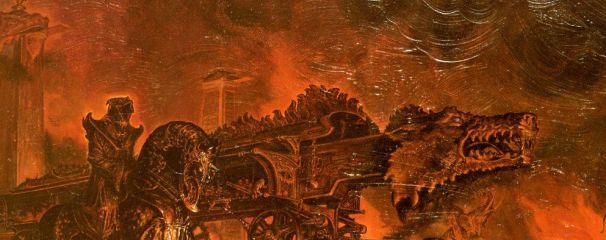
Grond
Grond is introduced, named after the hammer of Morgoth the first Dark Lord. It is shaped, described above, like the head of a great wolf with flames in its mouth. It rapidly advances toward the City. According to both Jackson and Tolkien the Gondorians rally round, prepared to defend the Gate. Then comes the dichotomy.
According to Tolkien this is what happens: Over the hills of slain a hideous shape appeared: a horseman, tall, hooded, cloaked in black. Slowly, trampling the fallen, he rode forth, heeding no longer any doubt. He halted and held up a long pale sword. And as he did so a great fear fell on all, defender and foe; and the hands of men drooped to their sides, and no bow sang. For a moment all was still. [5.IV.]
In the movie Grond is rammed against the Gate by Gothmog’s order and he supervises the ground troops whereas the Witch King seems to take the role of a modern field marshal, commanding the overall army.
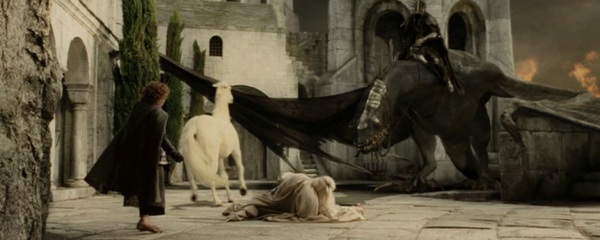
Gandalf vs. Witch King
After the gate is broken comes one of the biggest differences from the book and the movie relating to this particular portion of the story. In the book, the Lord of the Nazgul rides in alone after the breaking of the Gate and challenges Gandalf: The Black Rider flung back his hood, and behold! He had a kingly crown; and yet upon no head visible was it set. The red fires shone between it and the mantled shoulders vast and dark. From a mouth unseen there came a deadly laughter.
‘Old fool!’ he said. ‘Old fool! This is my hour. Do you not know Death when you see it? Die now and curse in vain!’ And with that he lifted high his sword and flames ran down the blade. [5.IV.]
In the movie this is quite different. After Grond breaks open the Gate, Trolls come lumbering in, followed by Easterlings, Wargs, and Orcs. The Gondorians immediately assume defensive positions but slowly but surely they are overwhelmed being pushed back to the next level. Pippin rushes down, informs Gandalf that Denethor has lost his mind; Gandalf grabs him and gallops up the City where he then meets the Witch King on his Fell Beast. Gandalf confronts him, and tries to drive him back. The Witch King breaks Gandalf’s staff and forces him to the ground, Pippin rushes at the Fell Beast but is driven back by fear. The Witch King is just about to strike in both book and movie when…
- 5.01. Minas Tirith by Morwinyoniel
- 5.05. The Ride of the Rohirrim by Rosearialelven
- Peregrin Took by AinarielPalantir
Interesting Links:
Our Gallery has has screencaps of the theatrical version, as well as the extended edition.
A transcript of 'The Lord Of the Rings: The Return of the King' can be found in our Film Fun & Facts section.
A summary of 'The Lord Of the Rings: The Return of the King' can be found in Elrond's Library.
Some articles that are related to this sequence:
- The Middle-earth Section of Elrond's Library has articles about Peregrin Took, The Stewards and the Royal Family of Gondor and Denethor, Son of Ecthelion.
There's also a family tree of the House of Stewards.
Forum threads related to this sequence:
- You can discuss this sequence in detail in ROTK Sequence by Sequence #8: Mordor Attacks (The Siege of Gondor) and ROTK EE Sequence by Sequence # 6: The Siege of Gondor in the Movies Forum. This Forum also has a thread about Denethor and Merry & Pippin: Comic Relief or Indepedent Characters.
- The Book Forum has threads about Denethor, Grond and Pippin.
- The Book Club discusses this chapter here.
Take a look at how some artists saw this part in the book:
- Minas Tirith by Paul Gregory
- Forlong by Quinton Hoover
- Imrahil by Ivar Allen
- Imrahil Tends to His Nephew by Anke Eissmann
- Your Son Has Returned, My Lord by Anke Eissmann
- The Siege of Gondor by John Howe
- The Siege of Minas Tirith by the Brothers Hildebrandt
- The Siege of Gondor by Stephen Hickman
- Grond by Paul Gregory
- The Witch-king by Alvaro Barros
- With-king of Angmar by ~Witch_Queen_of_Angmar~
Looking for something more creative - you may find it here:








